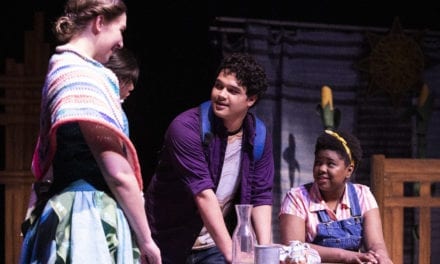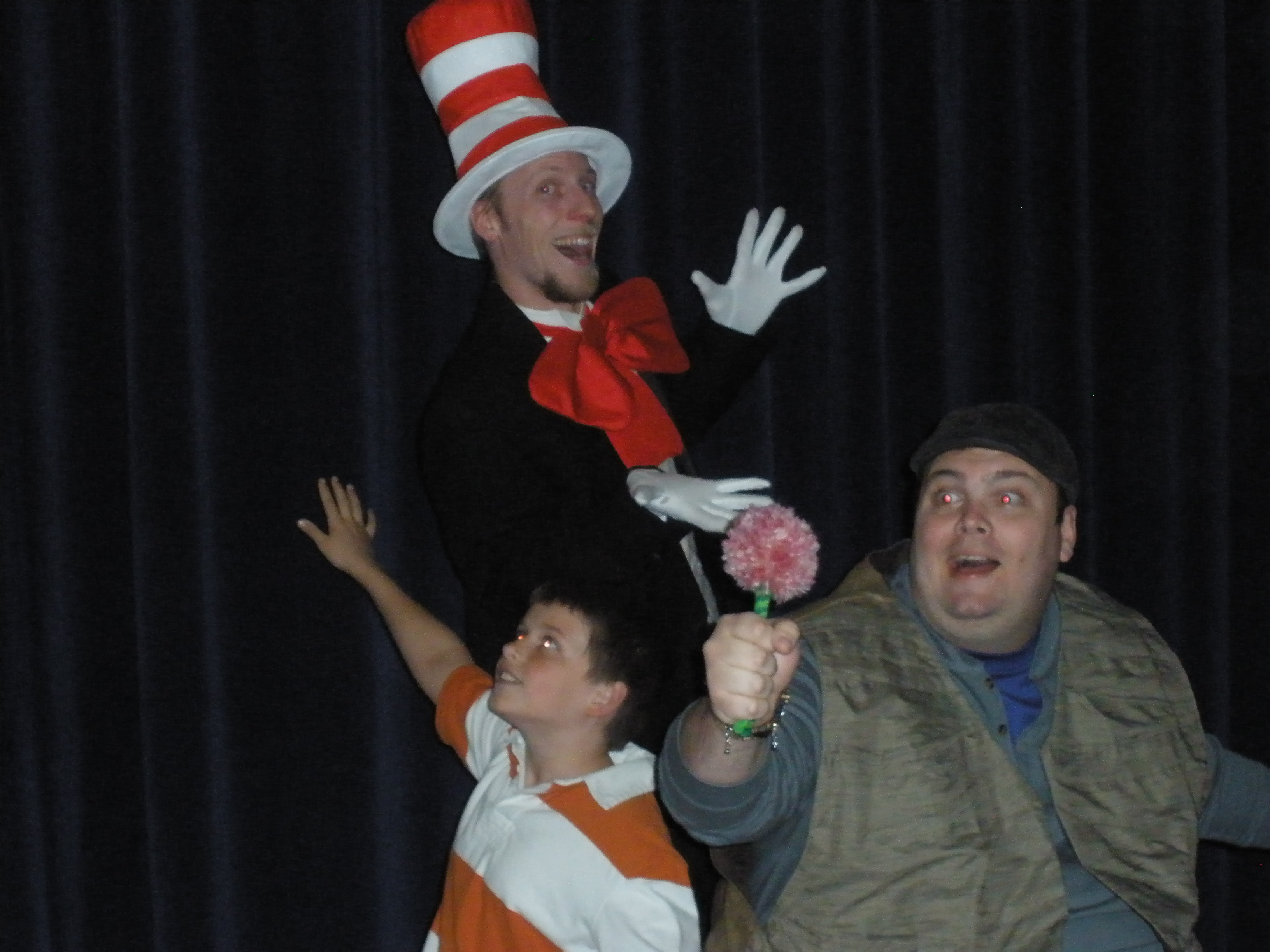SALT LAKE CITY — Just two weeks after the release of the film adaptation starring Anna Kendrick and Jeremy Jordan, Utah Repertory Theater Company has brought Jason Robert Brown‘s five year love story of Cathy Hiatt and Jamie Wellerstein to life on the Sugar Space stage. As Cathy, Erin Royall Carlson presents pivotal moments from end to beginning, starting with the moment Jamie leaves then traveling one song at a time backward to the beginning of their story. Rhett Richins, on the other hand, portrays Jamie’s viewpoint from beginning to end, following Jamie from his earliest moments with Cathy to the moment he decides to move on. Alternating each song, Cathy’s and Jamie’s individual scenes tell poignant stories of dreams, success, time, and loss. In the end, The Last Five Years provides an opportunity to reflect on what it means to love.
There was certainly plenty to love about this production. Before Carlson or Richins even sang a note, Anne Puzey’s skills as music director, pianist, and orchestra conductor set the tone of the evening. There was something powerful about the chords that cut through the dark silence or underscored the tensest moments of the production. Added to the piano was a small orchestra which filled the performance space without overpowering the vocalists and allowed Carlson and Richins to be flexible and genuine with their rhythm and tempo. The talents of Alex Ewoniuk on bass, Gary Gerber on guitar, Evelyn Partner and Rachel Jorgensen on cello, and Lisa Thurman on violin added layers and nuances to the music which would have disappeared without live music.
Much like the orchestra, the behind-the-scenes production crew worked together to create a seamless presentation with extraordinary attention to detail. Two of my favorites included the professional book jackets created for Jamie’s successful novel and the diamond ring which sparkled noticeably throughout “The Next Ten Minutes.” In addition, Nancy Susan Cannon’s costume design was both clever and beautiful. Each of Cathy’s pieces was flattering and well-fitted while also facilitating the many quick changes she had to make. Most impressive was when Jamie helped her unzip a cocktail dress to quickly reveal the denim shorts and black tank top required by the next scene. Jamie’s costumes, while a bit less flashy, showed his transition from college drop out to successful author. Finally, I was impressed by Joe Jenkins’s lighting design which remained simple while ensuring that only certain areas were lit in each scene. Although most songs featured only Jamie or Cathy, a few required one actor to sit, barely noticed, almost like a prop in the scene. For example, in “The Schmuel Song,” Jamie dances on and around the couch, entertaining and inspiring Cathy to take a chance. Meanwhile, Cathy sits on the couch with her back to the audience, presumably taking in the show. Despite the actors’ close proximity, Jenkins skillfully lit only Jamie throughout the song, leaving Cathy silhouetted in the darkness.
The director, John Sweeney used the small space to its full advantage. Even with the orchestra occupying a corner of the stage, Sweeney was able to create a variety of settings using only a few simple set pieces. This was possible largely due to a three-sided set piece which rotated to portray a set of steps, a pier, or the couch in Jamie and Cathy’s apartment as dictated by the scene. Each side of the stage also featured two chairs which could be positioned alongside a variety of real and imaginary furniture to create offices and dinner parties at will. Despite the sparse set pieces, the setting was always clear, which is a credit to both the staging and the convincing acting. I enjoyed watching both actors, blocked surprisingly close to the front row, get seemingly lost in the emotions of the characters and effectively shut out any potential distractions. In fact, there was only one moment during which the spell the actors cast seemed to be broken. In Cathy’s song, “A Summer in Ohio,” Cathy performed a cute dance with her air freshener, drawing whimsically in the air with its steady stream of fragrance much like a child spelling his name with a sparkler. While the dance was endearing, it left a tangible and overpowering scent of air freshener lingering in the air which traveled across the stage to where I was sitting. I found myself momentarily distracted by its taste and had to refocus before enjoying the remainder of the number.
Thankfully, it didn’t take much effort to be drawn in by Carlson as Cathy. Since she only gets to tell Cathy’s side of the story, Carlson frequently found herself engaged in one-sided arguments and conversations. It was in these moments that I found Cathy to be the most convincing. For example, as Cathy sat across the table from guests at a party who wanted to know what it was like to be married to Jamie, Carlson had me completely convinced that she was in fact talking to a living and breathing human being instead of the empty stage that actually lay before her. I was amazed at how strongly I felt the conflict as she argued with the air during “See I’m Smiling,” and I found myself wondering what it might have felt like to be on the receiving end of her sharp tongue. However, I had a harder time accepting Cathy in her happy moments. I felt that Carlson lost some of her passion the further into the show she got, and without the anger of Cathy’s chronologically later character, I thought Carlson’s voice became thin and a bit forced. I enjoyed her earlier numbers including “I’m Part of That” and “See I’m Smiling” more than the lighter “I Can Do Better Than That.”
As Jamie, however, Rhett Richins had few weaknesses. The song “I Keep Moving” was a showcase piece for Richins, highlighting both his rich low notes and his soaring upper register. At one point, he even sustained a note while jumping up and down excitedly on the stage. My favorite moments from Richins were when Jamie was telling a story. This happened most literally in “The Schmuel Song” and again later in “A Miracle Would Happen.” In those moments I could see why, despite his lack of classic good looks, a woman like Cathy would fall for him. In fact, in those moments I could see why Jamie had been able to achieve such great success so early in life. Richins’ depiction of Jamie was so charming, I could easily believe than when Jamie spoke, people couldn’t help but listen. Jamie’s most powerful story came during “If I Didn’t Believe in You,” a song in which Jamie tried once again to motivate Cathy to achieve her dreams. For me, this was the most emotional and heartbreaking moment of the show as Jamie told Cathy, “I will not lose because you can’t win.”
I can’t say for certain what writer and composer Jason Robert Brown intended for me to get out of this show, but I can say that I walked away with a greater desire to love better. To be like Jamie and believe in the dreams of those around me. To be like Cathy and put my own dreams second. To be like neither and somehow manage to make the difficult relationships last. Having seen both the recently released movie (not available in Utah theaters) and this live stage production, I can easily say which I preferred, and nothing can beat the passion of well-executed live theater. If you are interested in an emotionally dramatic story strung together by hauntingly beautiful melodies and driving beats, don’t miss Utah Rep’s production The Last Five Years.






